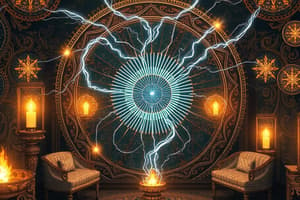Podcast
Questions and Answers
What does a charged body cause in an insulated conductor?
What does a charged body cause in an insulated conductor?
- Positive charge on both ends
- No charge
- Negative charge on both ends
- Positive charge on one end and negative on the other (correct)
Who discovered the principle of electrostatic induction?
Who discovered the principle of electrostatic induction?
- Van de Graaff
- Stephen Gray
- John Canton (correct)
- Johan Carl Wilcke
Which of the following uses the principle of electrostatic induction?
Which of the following uses the principle of electrostatic induction?
- Wimshurst machine (correct)
- Tesla coil
- Faraday cage
- Leyden jar
What is the effect of electrostatic induction on light nonconductive objects?
What is the effect of electrostatic induction on light nonconductive objects?
What is constant at any point throughout a conductor due to induction?
What is constant at any point throughout a conductor due to induction?
What alternate term is used for 'electrostatic induction' in Europe and Latin America?
What alternate term is used for 'electrostatic induction' in Europe and Latin America?
What type of objects are attracted to static electric charges due to electrostatic induction?
What type of objects are attracted to static electric charges due to electrostatic induction?
Which scientist is associated with the discovery of electrostatic induction along with Johan Carl Wilcke?
Which scientist is associated with the discovery of electrostatic induction along with Johan Carl Wilcke?
In which year was electrostatic induction discovered by Johan Carl Wilcke?
In which year was electrostatic induction discovered by Johan Carl Wilcke?
In the presence of a charged body, what develops on the ends of an insulated conductor?
In the presence of a charged body, what develops on the ends of an insulated conductor?
Flashcards are hidden until you start studying
Study Notes
Charged Bodies and Insulated Conductors
- A charged body induces a separation of charge within an insulated conductor, causing one end to become positively charged and the other negatively charged.
- In the presence of a charged body, induced charges develop on the ends of an insulated conductor, creating an electric field.
Electromagnetism Discoveries
- The principle of electrostatic induction was discovered by Johan Carl Wilcke.
- Benjamin Franklin is also recognized for his contributions to the understanding of electrostatic induction.
Applications of Electrostatic Induction
- Devices such as capacitors and electrostatic precipitators utilize the principle of electrostatic induction to function effectively.
Effects on Nonconductive Objects
- Light nonconductive objects, such as small bits of paper or plastic straws, can be attracted to charged bodies due to electrostatic induction.
Key Characteristics of Conductors
- Electric potential remains constant at any point throughout a conductor under electrostatic conditions due to induction.
Terminology Variations
- The term "electrostatic induction" is alternatively referred to as "induction electromagnetism" in Europe and Latin America.
Objects and Electrostatic Attraction
- Neutral conductive and nonconductive objects can be attracted to static electric charges through the process of electrostatic induction due to induced polarization.
Historical Context
- Johan Carl Wilcke discovered the principle of electrostatic induction in the year 1762.
Studying That Suits You
Use AI to generate personalized quizzes and flashcards to suit your learning preferences.




